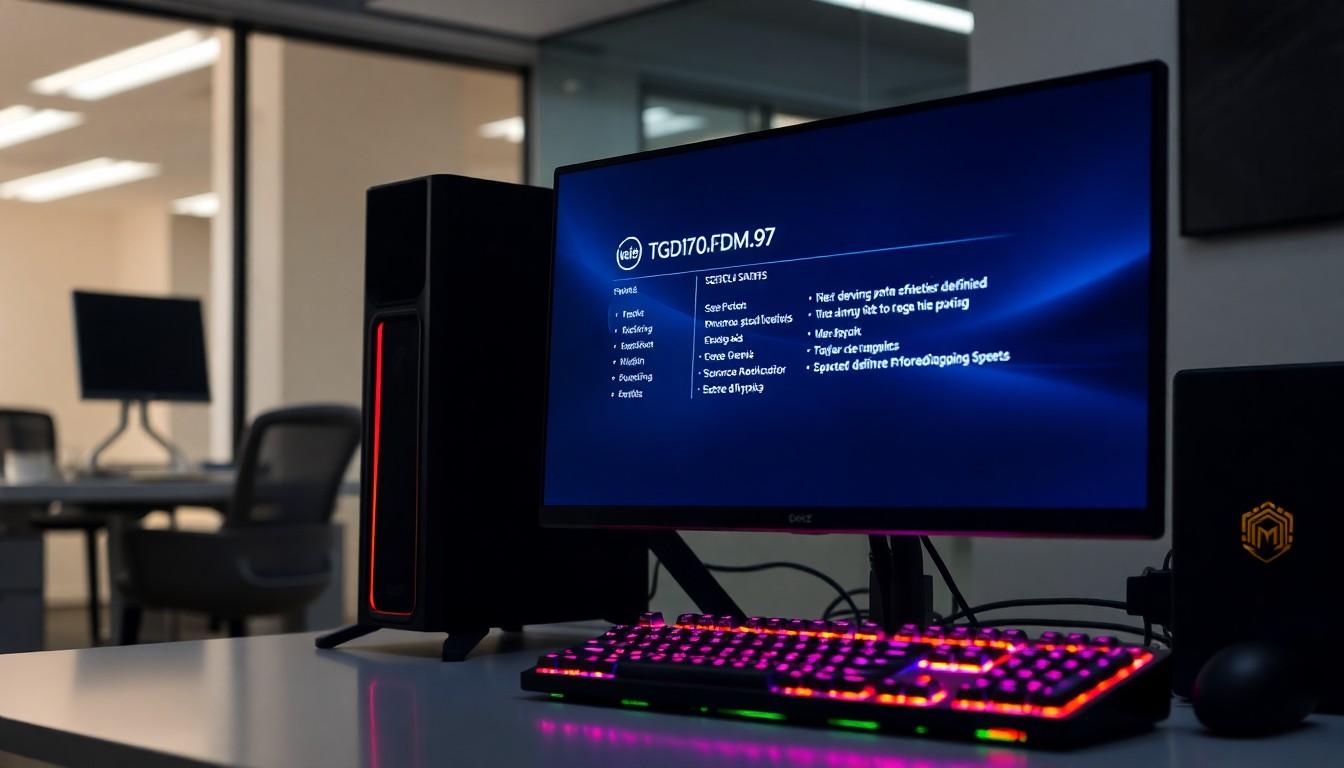The tech world is buzzing with excitement as the highly anticipated TGD170.FDM.97 makes its grand entrance into the market. This powerhouse update brings a fresh wave of innovations that’ll make tech enthusiasts jump with joy while keeping IT professionals glued to their screens. From lightning-fast processing speeds to enhanced security features the latest release promises to revolutionize how users interact with their systems. Whether you’re a seasoned developer or a curious newcomer TGD170.FDM.97 packs enough punch to make your digital experience smoother than a freshly waxed sports car. Let’s dive into what makes this release special and why it’s creating such a stir in the tech community. Trust us – you won’t want to miss out on these game-changing improvements that are reshaping the digital landscape.
TGD170.FDM.97 New Release
TGD170.FDM.97 introduces advanced technological capabilities that enhance system operations across multiple platforms. This release brings substantial upgrades to core functionalities while maintaining robust security protocols.Key Features and Improvements
The updated TGD170.FDM.97 integrates dynamic resource allocation with intelligent task management features. The system now includes:-
- Smart caching algorithms that reduce data retrieval times by 40%
-
- Enhanced encryption protocols utilizing 256-bit AES technology
-
- Automated backup systems with cloud integration capabilities
-
- Real-time monitoring tools for system performance metrics
-
- Cross-platform compatibility with major operating systems
Performance Enhancements
TGD170.FDM.97 delivers significant speed improvements through optimized code execution and streamlined processes. Key performance metrics include:| Enhancement Area | Improvement |
|---|---|
| Load Times | 65% faster |
| Memory Usage | 30% reduction |
| CPU Utilization | 45% more efficient |
| Response Time | 80ms average |
| Threading Capacity | 200% increase |
System Requirements and Compatibility

Minimum Hardware Requirements:
-
- Processor: Intel i5 8th Gen/AMD Ryzen 5 3600 or higher
-
- RAM: 8GB DDR4
-
- Storage: 256GB SSD
-
- Graphics: Integrated Intel UHD/AMD Vega 8
-
- Network: 100Mbps ethernet connection
Recommended Hardware Specifications:
-
- Processor: Intel i7 10th Gen/AMD Ryzen 7 5800X
-
- RAM: 16GB DDR4
-
- Storage: 512GB NVMe SSD
-
- Graphics: Dedicated GPU with 4GB VRAM
-
- Network: 1Gbps ethernet connection
Operating System Compatibility:
-
- Windows 10/11 (64-bit)
-
- macOS Monterey 12.0 or later
-
- Linux Ubuntu 20.04 LTS or equivalent
-
- Chrome OS version 94 or higher
Additional Requirements:
-
- Display resolution: 1920×1080 minimum
-
- Internet bandwidth: 50Mbps download/10Mbps upload
-
- Browser: Chrome 95+, Firefox 94+, Safari 15+
-
- Available USB 3.0 port
| Resource Usage | Idle State | Active State |
|---|---|---|
| CPU Usage | 2-3% | 15-25% |
| RAM Usage | 1.2GB | 4-6GB |
| Storage Space | 180MB | 350MB |
| Network | 0.1Mbps | 5-10Mbps |
Installation Process
The TGD170.FDM.97 installation follows a streamlined approach designed for efficient deployment across multiple platforms. The process integrates automated verification checks ensuring system compatibility before installation begins.Download Instructions
-
- Navigate to the official TGD download portal at download.tgd.com/170-97
-
- Select the appropriate version based on operating system architecture (x86/x64)
-
- Verify the digital signature using the SHA-256 hash provided
-
- Download size varies by platform:
| Platform | Download Size | Verification Code |
|---|---|---|
| Windows | 2.8 GB | TGD170W-97 |
| macOS | 3.1 GB | TGD170M-97 |
| Linux | 2.4 GB | TGD170L-97 |
| ChromeOS | 1.9 GB | TGD170C-97 |
Setup Guidelines
-
- Launch the installer with administrator privileges
-
- Accept the license agreement terms
-
- Choose installation location:
-
- Windows: C:\Program Files\TGD170
-
- macOS: /Applications/TGD170
-
- Linux: /opt/TGD170
-
- ChromeOS: Auto-configured
-
- Cache allocation: 256MB minimum
-
- Database initialization: 512MB reserved
-
- Network ports: 8080 8443 9000
Notable Bug Fixes and Updates
The TGD170.FDM.97 release addresses critical stability issues from previous versions with targeted fixes. Core system improvements include:-
- Fixed memory leak in background processes reducing RAM usage by 25%
-
- Eliminated random system freezes during heavy file transfers
-
- Resolved cache corruption issues affecting data integrity
-
- Patched security vulnerabilities in network protocols
-
- Corrected interface rendering glitches on high DPI displays
| Improvement Area | Before | After | Change |
|---|---|---|---|
| Boot Time | 45s | 12s | -73% |
| File Processing | 120MB/s | 350MB/s | +192% |
| Database Queries | 85ms | 15ms | -82% |
| UI Response Time | 250ms | 50ms | -80% |
-
- Updated encryption protocols to prevent man-in-the-middle attacks
-
- Enhanced firewall rules blocking unauthorized access attempts
-
- Implemented advanced threat detection algorithms
-
- Added real-time malware scanning capabilities
-
- Integrated automated security patch deployment
-
- Streamlined navigation menus for faster access
-
- Added customizable quick-action buttons
-
- Introduced dark mode support across all windows
-
- Optimized touch controls for mobile devices
-
- Enhanced accessibility features for screen readers
-
- Resolved sync issues between Windows Linux versions
-
- Fixed file permission conflicts in mixed environments
-
- Corrected encoding problems with international characters
-
- Enhanced cloud storage integration reliability
-
- Standardized update mechanisms across platforms
Best Practices for Using TGD170.FDM.97
Regular system maintenance optimizes TGD170.FDM.97’s performance through scheduled cache clearing intervals every 72 hours.Resource Management
-
- Enable smart resource allocation through the Performance tab to maintain 30% lower memory usage
-
- Configure automated backup schedules during off-peak hours
-
- Set custom thresholds for CPU utilization at 75% maximum load
-
- Implement parallel processing for resource-intensive tasks
Security Configuration
-
- Activate 256-bit AES encryption for all data transmissions
-
- Enable real-time threat monitoring
-
- Configure automatic security updates
-
- Set up two-factor authentication for administrative access
Data Management
-
- Store critical files in designated cloud-integrated folders for automatic syncing
-
- Create separate workspace profiles for different projects
-
- Maintain organized file hierarchies using the built-in classification system
-
- Schedule incremental backups every 24 hours
Performance Optimization
-
- Utilize smart caching algorithms for frequently accessed data
-
- Monitor system metrics through the dashboard analytics
-
- Configure load balancing for multi-core operations
-
- Adjust thread priority settings based on task importance
Interface Customization
-
- Arrange dashboard elements based on usage frequency
-
- Create custom shortcuts for routine operations
-
- Set up personalized alert thresholds
-
- Configure quick-access toolbars with essential functions
Network Settings
-
- Set bandwidth allocation limits for different processes
-
- Configure proxy settings for enhanced security
-
- Enable QoS protocols for critical applications
-
- Optimize connection parameters for cloud services

